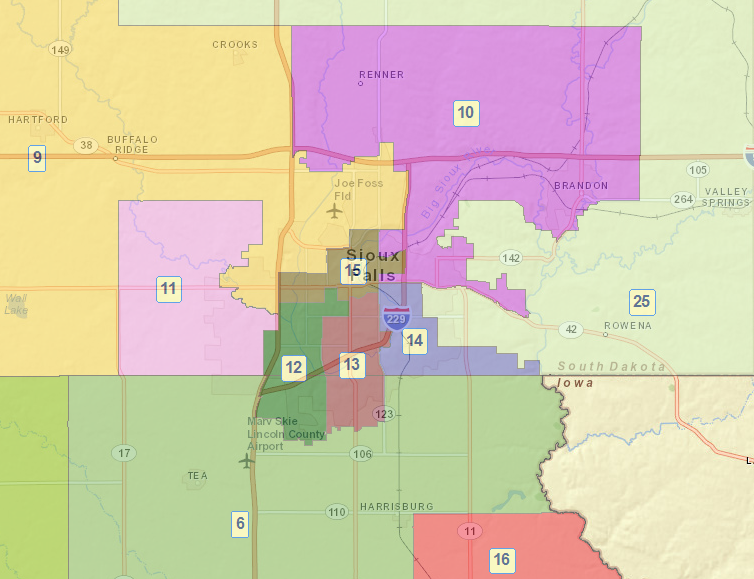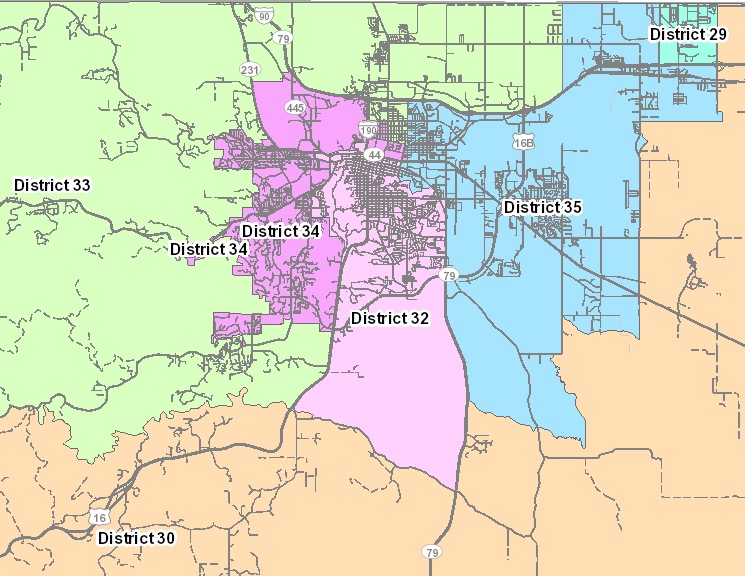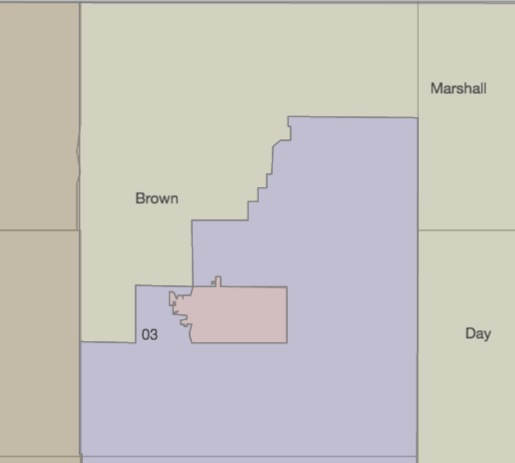I don’t want to ride Rep. Jim Stalzer (R-11/Sioux Falls) too hard. He wasn’t scheduled to speak at last night’s ballot question forum in Sioux Falls. Rep. Jim Bolin (R-16/Canton) was supposed to speak against Amendment T, the independent redistricting proposal, but yesterday’s rain flooded Rep. Bolin’s basement. Rep. Stalzer filled in for Rep. Bolin on very short notice. I respect Rep. Stalzer for accepting that challenge.
Unfortunately, Rep. Stalzer responded to that challenge with some misleading howlers.
Even though Rep. Stalzer did not participate in the last redistricting, in 2011, Rep. Stalzer said he talked with several members of the committee of legislators who drew their own boundaries in 2011. He asserted that the committee followed “the primary criterion” of respecting city limits, county lines, and other existing boundaries and not “how many Republicans, how many Democrats” resided in certain areas:
Rep. Stalzer, would you care to look at the maps around Sioux Falls, Rapid City, and Aberdeen and explain how all those squiggly lines represent any effort to maintain geographical or community integrity? Can you tell us how Democrats get concentrated into Sioux Falls District 15, how Rapid City’s American Indian population gets dispersed among districts, and how Chuck Welke and Burt Elliott get separated from their Brown County base without the 2011 redistricting commission looking at specific addresses and voter affiliation?



Rep. Stalzer also repeated the crocodile-tear concern that Amendment T does not require equal representation of all parties on the independent redistricting commission. Farmers Union spokesman Matt Sibley neatly shot down that point by reminding the audience that Amendment T removes the conflict of interest of legislators drawing their own districts. Sibley also noted that any biases among redistricting commissioners will be checked by the new constitutional safeguards by which T prohibits the commission from looking at the voter affiliation data and specific names and addresses that a biased commissioner would need to rig map lines to favor one party or one candidate over another. Rep. Stalzer reasserted that politics did not guide the 2011 redistricting:
On a question about cost and taxes, Sibley said T will save money, since it cuts the size of the redistricting committee from fifteen legislators to nine independent redistricters. Rep. Stalzer pointed out that the immediate extra redistricting T calls for in 2017 would cost more money.
Rep. Stalzer’s grousing about having to redo his campaign signs only further exposes the self-interest that prevents legislators from passing a fair redistricting proposal. But he also misses the long-term savings of a smaller independent redistricting commission. Rep. Stalzer doesn’t rebut Sibley’s math on commission size, so let’s use it.
Sure, the immediate off-Census 2017 redistricting would be an added cost (call it 9x, where x is the per-diem cost for each commission member). By 2021, when we get back to the post-Census redistricting routine, we would spend another 9x, at which point our total redistricting cost post-T would be 18x, versus a mere 15x for one standard decennial redistricting by the Legislature. But by 2031, T will have spent money on three redistrictings by nine committee members each time for a total cost of 27x, while under the status quo, we will have paid for two redistrictings by fifteen committee members each time for a total cost of 30x. Within two standard decennial redistrictings, Amendment T saves us money. By 2101, Amendment T saves us 33% on redistricting costs. T gives us fairer election maps and saves us money to boot.
Asked whether Amendment T would really eliminate gerrymandering, Sibley said yes and repeated that T’s safeguards will eliminate conflict of interest. Not addressing gerrymandering, Rep. Stalzer contended that the fact that “a number of people in my party ended up getting redistricted into the same district and having to run against each other” demonstrates that the legislators draw district lines “based on the criteria that the people asked for” rather than party interest:
The howler here is that Rep. Stalzer cites Rep. Lora Hubbel’s gerrymandering into an incumbent-filled district as an example of the lack of self-interest or partisan gaming of the current redistricting process. To the contrary, Rep. Lora Hubbel’s sacking is a glaring example of how the majority will use redistricting to punish its own members who fall into disfavor. The Republican majority wanted Lora Hubbel out of the Legislature as surely as they wanted to vanquish Frank Kloucek. Lora Hubbel’s fate in 2011 and 2012 exemplifies exactly the self-interest that corrupts the current redistricting process. Amendment T would eliminate exactly that self-interest and produce more fair legislative district maps.
Rep. Stalzer defended the Republican position against independent redistricting as gamely as he could. Even with more notice, Rep. Stalzer would have struggled to come up with plausible arguments to cloak the Republican Party’s real intent in opposing Amendment T: to cling to their power to rig the map for their favored candidates.
Let’s see. Districts created by politicians/for politicians vs. districts created by independent commission without looking at voter registration data and names. Nuff said.
Of the various measures SDGOP is opposing, it seems they have to reach hardest for arguments with this one.
Cory, you are better than the newspapers.
I can not find it within myself to respect, in the slightest, the logic purported by Stalzer. Fighting for status quo in an area where there’s a lot of room for improvement should very well be a thankless task, but additionally, to hell with all the junk that came out of his mouth. He may as well have just said, “We use corruption for the good, in South Dakota, and Liberals just don’t understand how important corruption is to how our state government operates.”
Thanks, Adam! I get the impression I’ve at least given Thursday’s event more analysis than the papers. Have any of the TV stations written anything about the event? I didn’t see any of their reporters there.
I agree that Rep. Stalzer’s arguments were poppycock. But the same thing happens at HS debate tournaments: I can respect the kids who fill in at the last minute for a sick teammate and stand before the opposition and the judge with minimal preparation even as I write a ballot explaining how every argument they offered falls short.
I have learned 5-10x more about what’s going on in 2016 statewide politics through your blog than what any ‘news’ outfit has offered me.
No one ever televises these things in SD. Every election cycle, the news seems to pretend people aren’t so interested in video of political dialogue, and they just don’t make this stuff available to the public.
I can see where respect for children filling in at the last minute is quite respectable, but in this grown up professional world – where lives are at stake – if your not prepared to properly argue for something then you don’t believe in it enough to justly speak on its behalf. I guess Stalzer is no bigger looser than any other SDGOP member who might take his place – arguing for corruption.
Thanks, Adam. I can see the merit of your expectations that a sitting legislator and candidate for office ought to know the ins and outs of how his legislative district boundaries are drawn. Stalzer, like the other Republicans, faces the challenge of trying to pretend that their opposition to Amendment T is based on principle rather than naked self-interest.